Mannanoligosaccharide as a Natural Feed Additive for Piglets
Mannanoligosaccharide: its Logical Role as a Natural Feed Additive for Piglets
Published: December 5, 2007
By: PETER SPRING and MARIUS PRIVULESCU (Courtesy of Alltech Inc.)
Those changes in intestinal morphology have been associated with animal health and performance, since they lead to poor nutrient absorption and increased secretion in the gastrointestinal tract. The resulting malabsorption syndrome makes the piglet more susceptible to diarrhea. In addition to the nutritional situation, environmental changes as well as social changes (separation from the dam, new penmates) put additional stress on the young pig. Due to those stressors maintaining animal health and optimizing performance post-weaning are challenging goals for the pig producer and the nutritionist.
The reduction of weaning age implemented in commercial production units over recent years has further increased the need for close attention to weaning diets. A high quality diet for piglets must provide the required nutrients in easily digestible forms and must contain the right combination of feed additives. Biotechnology has brought a number of new feed additives to the nutritionist. Scientific progress and availability of new technological procedures allow development of new feed additives which have proven very useful in improving animal health and production. On the other hand, governmental regulations and consumerism are restricting the use of feed additives.
Getting the weanling piglet off to a quick start with minimum growth check is essential for successful hog production. New management practices and more stringent regulation on the use of feed additives are rapidly changing the way we are weaning piglets. Those changes create a need for new nutritional approaches to improve piglet health and performance.
WHAT NUTRITIONAL ALTERNATIVES TO ANTIBIOTICS ARE AVAILABLE TO OPTIMIZE PIGLET HEALTH AND PERFORMANCE?
The innate intestinal microflora play a crucial role in maintaining health in the young animal. Many feed additives are intended to reinforce the modes of action of the indigenous microflora in protecting the host from disease (Figure 1). The gastrointestinal microflora can work directly to fight gastrointestinal pathogens by competitive exclusion. However, the microflora also interact with the animal’s immune system to enhance immune response when challenged by pathogens.
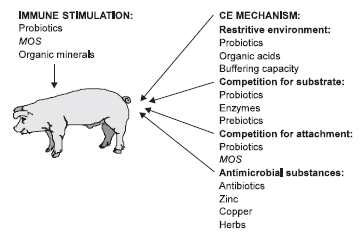
Figure 1. Approaches the indiginous microflora take to protect animal health and nutritional tools to reinforce those mechanisms.
ANTIMICROBIAL LEVELS OF COPPER SULFATE AND ZINC OXIDE
Antibiotics have proven over many years to be a very valuable tool to protect animal health. However, the increase in bacterial resistance and regulatory measures are changing the way pig producers will use antibiotics in the future. These changes have created a need for new nutritional approaches to protect animal health. Copper and zinc, two minerals with antimicrobial activity, are certainly valuable alternatives. Zinc has proven very effective in maintaining piglet health in Sweden after the government implemented a ban on antibiotic growth promotors in 1986. However, environmental problems associated with levels of these minerals excreted in manure will limit future use.
In a small country such as Switzerland the use of 2,000 ppm zinc in all weanling diets (~15 kg feed/piglet) would create an extra environmental load of 120 tonnes of zinc per year. In the US this figure would come to 7,200 tonnes. Excessive use of those minerals will provoke establishment of environmental regulations. Such regulations will confine upper inclusion rates in feed close to known nutritional requirements. These levels would be well below the concentrations needed to achieve an antimicrobial effect.
MANNANOLIGOSACCHARIDES FROM YEAST
Antimicrobial compounds derived from different plants might offer a more natural approach to controlling gastrointestinal pathogens (Newman, 1997).
However, it seems rather unlikely that alternative antimicrobial compounds alone will bring about the improvements the producer needs to optimize production.
An approach combining feed additives with very different modes of action is more likely to succeed. Yeast products can play a central role in such an approach since they have the potential to improve animal health via competitive exclusion as well as immune stimulation.
Yeasts have been used for many years as a high quality protein source in animal diets. Their high content of vitamins, enzymes and other important co-factors also made them attractive as a digestive aid in ruminants and monogastric animals (Dawson, 1994). The positive effects of live yeast cultures have mainly been associated with yeast metabolites (Girard, 1996). Only recently has evidence accumulated that some of the positive effects of yeasts in monogastrics might be associated with the yeast cell wall.
Oligosaccharides, with mannose as the primary carbohydrate (MOS), derived from yeast cell wall have been shown to improve health and performance in monogastric animals. MOS can block attachment of certain bacteria to the intestinal wall.
Bacteria that attach via Type I fimbriae (mannose-bearing lectin) bind dietary MOS instead. Most likely by means of pathogen adsorption, addition of MOS to the diet has led to reduced cecal salmonella concentrations in poultry and fecal coliform concentrations in calves (Newman et al., 1993; Spring, 1997).

Figure 2.Stressors that can compromise the immune system and affect health and performance of the weanling piglet.
In addition to the ability to influence colonization, MOS derived from yeast cell wall has also been shown to enhance function of the non-specific immune system. The exact mechanisms are not fully understood; however, stimulatory properties have been observed in different species suggesting that the immunological benefits with MOS are not species specific and could therefore be useful in piglets. The stressors to which the piglet is exposed demand optimum response of the developing immune system (Figure 2).
EFFECT OF MOS ON IMMUNE RESPONSE IN PIGLETS
The immunostimulatory properties of MOS have been investigated in different species. In two independent studies, Czech and Japanese researchers have determined increased activity of phagocytic cells from mice fed MOS (Sisak, 1994; Zennoh, 1995). In vivo stimulation of the specific immune system with MOS has been demonstrated in turkeys. Savage et al. (1996) reported increased concentrations of IgG and IgA with MOS addition. Since possible interactions of MOS with the immune system of the pig have not been investigated to date, researchers at the Pasteur Institute in Bucharest have focused on investigations of the ability of MOS to strengthen the immune defense of the piglet. Because the native microflora interact with the immune system, the study was conducted with both germfree and conventionally-reared piglets. This allowed a determination of whether the stimulatory properties of MOS are affected by the antigenic co-stimulation of the innate microflora.
EFFECTS ON HUMORAL IMMUNITY
The trial was conducted with newborn piglets. Over a sixty day period different parameters of both the humoral and the cell-mediated immune system were monitored. Effects of MOS on the humoral immune system were evaluated by measuring IgA, IgG and IgM levels in the bile, the intestinal content and the blood serum. IgA was determined by indirect ELISA while IgG and IgM were measured by radial immunodiffusion. Ig levels in the bile did not differ between conventional and germfree piglets (Table 1). However, conventional piglets had significantly higher Ig levels in the intestinal content as well as in the blood serum.
MOS addition led to an increase in both intestinal and serum Ig levels in germfree animals. The immunostimulatory response of MOS was less pronounced in the conventional piglets where higher Ig levels were only noted in the small intestine. This finding was underlined by a significant increase in the number of B lymphocytes in the intestine of conventionally-reared piglets fed MOS.
EFFECTS ON CELL-MEDIATED IMMUNITY
MOS also showed interesting effects on the cell-mediated immune system. In general, the conventionally-reared animals had a higher cell-mediated immune status compared to the germfree animals. The number of total T lymphocytes and of T lymphocyte subtypes participating in intestinal immunity were highly variable and rendered inconclusive evidence of a possible effect of MOS.
Table 1.Effect of Bio-Mos on humoral immune response in germfree and conventional piglets.
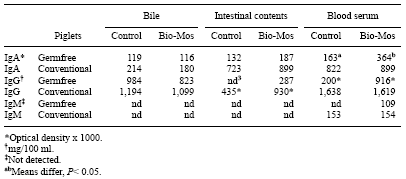
However, MOS increased the release of cytokines. Cytokines play a important role in the immune response since they coordinate the action among different cells of the immune system. MOS supplemented pigs had enhanced levels of interleukin-2 (IL-2). IL-2 is also known as T-cell growth factor and is required for T-cell proliferation and differentiation. A stimulatory effect of MOS on T-cell function was confirmed in vitro where MOS increased the reactivity of the intestinal lymphocytes as measured by the lymphoblast transformation test (Figure 3).
In addition, MOS led to an increase in IFN-g a cytokine released by the activated T-cell. The presence of IFN-g enhances the migration of leukocytes, fluid and protein to the infection site and activates the macrophage to allow it to kill engulfed bacteria. Enhanced macrophage activity (phagocytosis) with MOS was confirmed by enhanced killing of Staphylococcus aureus in vitro (Figure 3). Those stimulatory properties of MOS were noticed in both germfree and conventional animals. Those findings are in agreement with findings made in mice that also showed increased activity of phagocytic cells (Sisak, 1994; Zennoh, 1995).
Results of these studies clearly demonstrate that MOS has immunostimulatory properties in piglets. MOS was shown to stimulate both the cell-mediated and humoral immune system. Stimulation of cellmediated immunity was noted in both germfree and conventional piglets. However, the effect of MOS on the humoral immune response was influenced by the intestinal microflora. The fact that MOS showed the bigger response in germfree piglets indicated that MOS will exert the strongest immunostimulatory properties in young animals with an immature gastrointestinal microflora. Those findings might help to explain why MOS has been shown particularly effective at stimulating the humoral immune system in young turkeys (Savage et al., 1996). Turkeys are hatched in a relatively sterile environment. It therefore takes them longer to develop a mature microflora than poults raised in the proximity of the hen.
These trials conducted in piglets confirm earlier findings in experiments with other species that dietary MOS has the ability to strengthen the immune system. The ability of MOS to increase the phagocytic ability of white cells in the intestine could prove particularly important in the young pig since gastrointestinal infections are of major concern in the piglet.

Figure 3. Effect of Bio-Mos on lymphoblast transformation and phagocytosis.
RESPONSE TO MOS UNDER COMMERCIAL CONDITIONS IN BELGIUM
To the nutritionist MOS offers a nutritional route to provide additional protection against enteric pathogens and to enhance the animal’s ability to defend itself against different stressors. However, the true value of changes in immunological parameters to pig health and performance can only be evaluated in performance trials.
A trial involving 300 piglets was conducted in Belgium to evaluate the effect of Bio-Mos, a source of MOS, on animal health and performance under commercial conditions (Van der Beke, 1997). Bio-Mos was tested alone and in combination with Lacto-Sacc, a probiotic combining lactic acid bacteria and viable yeast culture. Piglets weaned at three weeks of age were fed barley-wheat based diets containing 2,340 kcal net energy, 18.5% crude protein and 1.17% lysine ad libitum. Olaquindox was included as an antimicrobial growth promoter. Two periods were considered: weaning to 14 days post-weaning and 14 days until piglets weighed approximately 16 kg.
Both supplements Bio-Mos (2 kg/t) and the combination Bio-Mos (2 kg/t) plus Lacto-Sacc (1 kg/t) improved piglet performance (Table 2). The addition of Lacto-Sacc and Bio-Mos reduced the incidence of diarrhea treatments compared to the control. Bio-Mos and the combination of the two natural additives increased growth rate (7 and 10%, respectively; Figure 4) and improved feed efficiency (5 and 9%, respectively; Figure 5) compared to the control.
Table 2.Effect of Bio-Mos and Lacto-Sacc on performance and health of piglets weaned at 21 days.
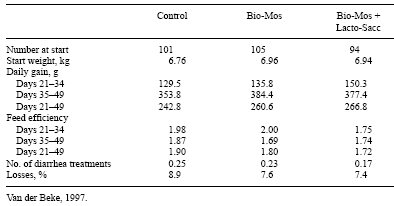
When piglets were separated by weaning weight into three categories (heaviest, medium and lightest), the piglets weighing least at weaning (< 5.9 kg average) responded best to Bio-Mos supplementation (Table 3). This is not surprising since it has been shown that smaller piglets are more likely to be stressed at weaning and will therefore respond more markedly than piglets more physiologically prepared for weaning. A better response in the smaller piglets would be expected to result in more uniform animal groups, a response often reported in field experience with Bio-Mos.
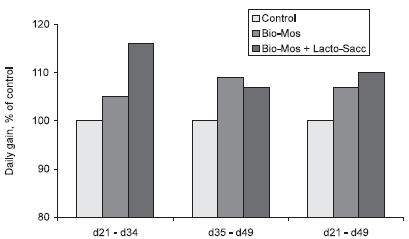
Figure 4.Effect of Bio-Mos and Lacto-Sacc on relative daily live weight gain (% of control).
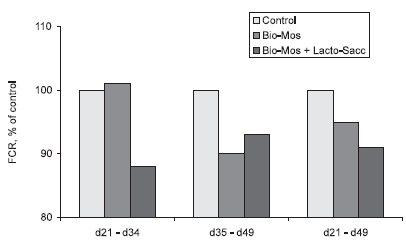
Figure 5.Effect of Bio-Mos and Lacto-Sacc on relative FCR (% of control).
Table 3.Effect of weaning weight on relative response to treatment.
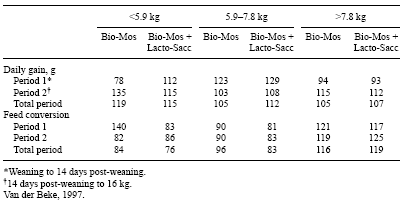
The addition of Bio-Mos resulted in a return on extra outlay (REO) of 6.4:1. For the combination of Bio-Mos and Lacto-Sacc the REO was calculated to be 5.4:1.
SUMMARY
Yeast products are playing a central role in nutritional approaches to improve animal health and performance as the industry at large gradually shifts away from reliance on antibiotic growth promoters.
MOS derived from yeast offers an additional tool to the nutritionist to support animal health and thereby optimize performance. This complex carbohydrate added to the diet is unique in its role in cell-mediated immune function along with its role in pathogen attachment. Unaffected by feed processing and conditioning procedures, Bio-Mos can be used in combination with antibiotics or in diets where the use of antimicrobial agents is no longer allowed or desired.
REFERENCES
Dawson, K.A. 1994. Manipulation of microorganisms in the digestive tract: The role of oligosaccharides and diet specific yeast cultures. California Nutrition Conference for Feed Manufacturers.
Girard, I. 1996. Characterization of stimulatory activities from Saccharomyces cerevisiae on the growth and activities of ruminal bacteria. Dissertation, University of Kentucky, Lexington, KY.
Nabuurs, M.J.A., A. Hoogendoorn, E.J. Van der Molen and A.L.M. Van Osta. 1993. Villus height and crypt depth in weaned pigs reared under various circumstances in the Netherlands. Res. Vet. Sci. 55:78–84.
Newman, K.E. 1997. Herbs and spices: Their role in modern livestock production. In: Biotechnology in the Feed Industry, Proceedings of the 13th Annual Symposium (T.P. Lyons and K.A. Jacques, eds), Nottingham University Press, Loughborough, Leics, UK. pp. 217–224.
Newman, K.E., K. Jacques and R. Buede. 1993. Effect of mannanoligosaccharide on performance of calves fed acidified and non-acidified milk replacer. J.Anim. Sci. 71(Suppl. 1):271.
Savage, T.F., P.F. Cotter and E.I. Zakrzewska. 1996. The effect of feeding a mannan oligosaccharide on immunoglobulins, plasma IgG and bile IgA of Wrolstad MW male turkeys. Poultry Sci. 75(Suppl. 1):43–145.
Sisak, F. 1994. Bio-Mos-mediated stimulation of phagocytosis as assessed by luminol-enhanced chemiluminescence. Czech Research Institute.
Spring, P. 1997. Effect of mannanoligosaccharide on different cecal parameters and on cecal concentration of enteric pathogens in poultry. Dissertation. Federal Institute of Technology, Zurich, Switzerland.
Van der Beke, N. 1997. Het gebruik van mannanligosacchariden (Bio-Mos) en lactobacillen (Lacto-Sacc) in biggenvoeders. Thesis. Highschool Gent, Department Biotechnological Sciences, Landscape Management and Agriculture, Gent, Belgium.
Zennoh Ltd. 1995. Effect of oral administration of Bio-Mos on stimulation of spleen-derived monocytes from mice. Poster presented at the 11th Annual Symposium on biotechnology in the Feed Industry. Lexington, KY, May 20–22.
Authors: PETER SPRING1 and MARIUS PRIVULESCU2
1 North American Biosciences Center, Alltech Inc., Nicholasville, Kentucky, USA
2 National Institute of Veterinary Medicine, Pasteur Institute, Bucharest, Romania
Related topics:
Recommend
Comment
Share

Would you like to discuss another topic? Create a new post to engage with experts in the community.






